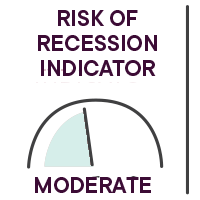Yann Furic
B.B.A., M. Sc., CFA®
Senior Portfolio Manager, Asset Allocation and Alternative Strategies
Waiting for Jackson Hole
Part of August passed in anticipation of the speech by U.S. Federal Reserve Chairman Jerome Powell, which was due to take place at the Fed’s meeting in Jackson Hole, Wyoming. This communication was to disclose the Fed’s intentions regarding the reduction of its bond purchases.
Focus on the past month

Overview of global equity markets*
- The flagship index of the Canadian stock market, the S&P/TSX, advanced 1.5% in August.
- In the United States, the S&P 500 gained 4.2% and the Nasdaq, 5.4%.
- International stock markets were also in positive territory during the month, with the EAFE Index climbing 2.8%.
- Emerging market equities rose 3.7% in August, while Chinese stocks edged up 1.2%.
* All the percentages in this section are in Canadian dollars. Bloomberg unless otherwise indicated.
Key events

Fed in the spotlight
The Fed’s inflation target was reached and job creation seems well under way. The Fed should therefore start tapering its bond purchases by the end of the year, meaning that it would continue to inject liquidity into the system, but at a slower pace.
Growth decelerating
Most economic measures are showing signs of slowing: growth is not negative, but the rate of growth is easing. Supply problems in certain industries such as automobile manufacturing are reducing potential GDP growth and could maintain inflationary pressures longer than expected.
Evolution of COVID-19 and vaccination
In North America, the rapid spread of the Delta variant is threatening the return to school of youngsters this fall, which could limit the availability of many workers. Border closures have also had a negative effect on immigration and on the presence of seasonal or temporary workers.
Employment situation
The U.S. job creation number of 235,000 for August fell short of expectations of 733,000. The recreation, hospitality and teaching sectors seem to be the ones that experienced slower-than-expected growth due to the consequences of the Delta variant. The unemployment rate fell from 5.4% to 5.2%, and the labour force participation rate remained stable at 61.7%.
In Canada, more than 90,200 jobs were created, beating forecasts of 68,200. The unemployment rate fell from 7.5% to 7.1%, while the labour force participation rate edged down to 65.1% from 65.2% last month.
Performance of our funds
View the returns

Our strategic monitoring
Main risks
Here are some risks that we are closely monitoring in the current environment.
- The cyclical recovery could be limited or delayed by various vaccine production problems, the speed of vaccination campaign rollouts, or the spread of a vaccine-resistant variant.
- Global supply chains are experiencing disruptions which, if they continue for several more months, could cause inflation to rise and reduce the production of goods and services. Such a situation would generate an episode of stagflation.
- A large-scale cyberattack could undermine positive sentiment concerning the reopening of the global economy and consumer confidence.
- A rapid, sharp rise in interest rates would lower the price/earnings ratio, which would cause stock indices to fall.
- Governments could significantly increase corporate and personal tax rates to replenish their coffers. However, this scenario is unlikely in 2021.
Fundamental indicators
Some economic indicators we continued to follow in August.
Consumer confidence ![]()
Consumer confidence fell sharply in August, as government assistance programs ended. The surge in COVID-19 infections as the return to school approaches also weighed heavily on this indicator.
U.S. personal savings ![]()
The personal savings rate remains high. Supply chain problems, insufficient semiconductor production and a worker shortage are limiting purchases of certain categories of goods and services. For example, new car production is down this year, limiting the ability of consumers to buy a new vehicle.
Global Purchasing Managers’ Index ![]()
The index remains above 50, indicating an increase in purchasing managers’ intentions. The index peaked in May 2021 at 58.5, and is now at 52.6. Intentions continue to be positive, but have been declining in recent months.
Benchmark rates in Canada, Europe and the United States ![]()
Rates remain favourable for an economic recovery. This situation should continue until economies return to a satisfactory rate of growth and a low unemployment rate.
François Landry
CFA®
Vice-President and Chief Investment Officer
Vice-Chairman of the Board of Directors of Professionals' Financial - Private Management
Our strategies
(6-to-12 month horizon)
The strategic target for the FDP Tactical Asset Allocation Private Portfolio is 55% equities and 45% bonds. Considering market movements, the equity weighting is now 69%, while the bond weighting is 31%.
The geographic allocation of equities in our portfolios shows greater exposure to cyclical sectors. We are overweight Canada, the EAFE zone and the United States. We have no position in emerging markets. Sector or factor positioning varies from region to region.
- In terms of Canadian equities, we have had a favourable bias towards banks for several months and we maintained our exposure to financial services. Canadian banks are still expected to get the regulatory go-ahead in the next few months to raise their dividends and resume share buybacks.
- As far as U.S. equities are concerned, our exposure to stocks in the technology and industrial products sectors remains unchanged. A few months ago, we initiated a position in copper producers, as demand for this metal should benefit from announced infrastructure spending on renewable energies as well as increased demand for electric vehicles.
- As for the EAFE Index (Europe, Australasia, Far East), we have an overweight position due to the index’s greater exposure to more cyclical sectors. Although the fiscal and monetary measures introduced in Europe are less aggressive than those implemented in North America, the zone should nevertheless benefit from an increase in commodity prices.
François Landry, CFA
Vice-President and Chief Investment Officer
Yann Furic, B.B.A., M. Sc., CFA
Senior Portfolio Manager, Asset Allocation and Alternative Strategies
Sources: Bloomberg
The opinions expressed here and on the next page do not necessarily represent the views of Professionals’ Financial. The information contained herein has been obtained from sources deemed reliable, but we do not guarantee the accuracy of this information, and it may be incomplete. The opinions expressed are based upon our analysis and interpretation of this information and are not to be construed as a recommendation. Please consult your Wealth Management Advisor.




















